
Commercial Bank investment pattern
- Subject:
- Business and Communication
- Finance
- Material Type:
- Lecture
- Date Added:
- 02/14/2019

Commercial Bank investment pattern
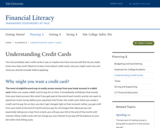
You have probably seen credit cards in use, or maybe even have one yourself. But do you really know how they work? Read on to learn more about credit cards, why you might want one, and what you should consider before applying.

Students and explores the fundamental concepts of credit, creditworthiness, and the long-term consequences of financial decisions.
Class Time Needed: 75-150 minutes depending on length of discussion, and time to complete notes and manipulatives

To help students understand that federal, state, and local governments need revenues to provide goods and services for their residents

Students read a handout about taxes and respond to questions to explore the relationship between working and taxes.
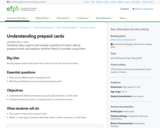
Students play a game and answer questions to learn about prepaid cards and explore whether they’d consider using them.

Students analyze statements about taxes to better understand how taxes affect people’s paychecks.

This lesson plan can be used as a review for the first unit test. The product created by the students (either a PowerPoint or poster) can be graded and/or used as review material for the 1st unit test (cheat-poster maybe?).

The Use of Blockchain Technology in the Insurance IndustryThe Use of Big Data in Retail BankingThis research topic looks at the use of big data in retail banking. It assesses the potential benefits of using big data to improve customer segmentation and target marketing campaigns.
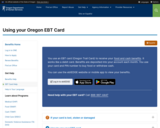
You use an EBT card (Oregon Trail Card) to receive your food and cash benefits. It works like a debit card. Benefits are deposited into your account each month. You use your card and PIN number to buy food or withdraw cash.

Unit plans, videos, and interactive practice aligned to Utah's General Financial Literacy (GFL) course standards.

Lecture notes for risk and valuation models for financial risk management , part 1
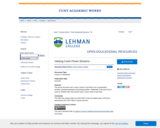
This lecture discusses how to value a series of cash flows such as perpetuities, annuities, growing perpetuities and growing annuities. Additionally, it discusses how to solve for variables other than present value or future value of cash flows.

Students will learn that the Federal Reserve uses interest rate policies to promote maximum employment and price stability. They will participate in an activity to demonstrate how a change in the target range for the federal funds rate transmits through the economy.

Breakdown of money illusion

Most of us use credit cards, and many of us have credit card debt. Economists and personal finance gurus disagree on the best strategies for paying off that debt across multiple credit cards. Check out our February 2023 issue of Page One Economics®: Focus on Finance to see why.

When someone needs to purchase a major appliance or vehicle, how do they go about making a decision on what to buy? This unit will help students develop skills to answer that question and give practice in making purchasing decisions on their own.
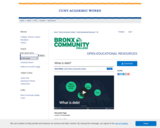
This video gives an overview of the five components of a debt and the corresponding keys of each of the components on a TI BA II Plus financial calculator.

Students will define compound interest, distinguish it from simple interest, calculate compound interest using a compound interest rate calculator, and apply the concept to real-life scenarios.
Class Time Needed: 90 minutes

Have you ever thought about Accounting as a career choice? With a refreshing, funky approach, this course will introduce you to the basic concepts, principles and techniques of being an accountant. You will learn about the importance of accounting in modern societies and have the opportunity to explore two different Accounting specialisations- Financial Accounting and Management Accounting. This course is a MOOC that runs twice per year and is being offered partially in Chinese (Mandarin) and fully in English as a partner project between Charles Darwin University in Darwin, Australia and Anhui Normal University, Wuhu, China. "Who's Counting: An Interactive Introduction to Accounting" by Charles Darwin University is licensed under CC BY-SA 4.0 unless individual parts labelled otherwise.